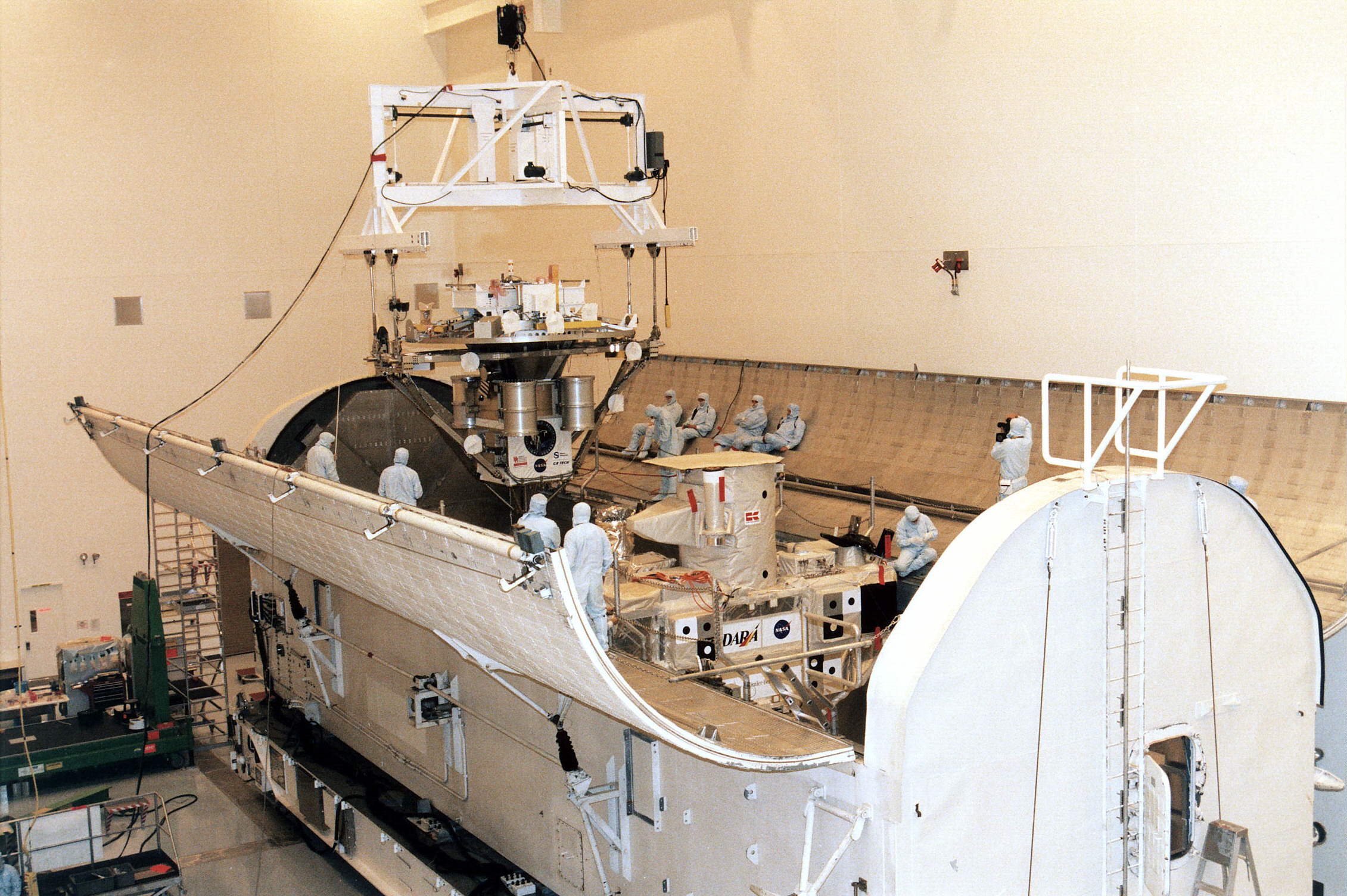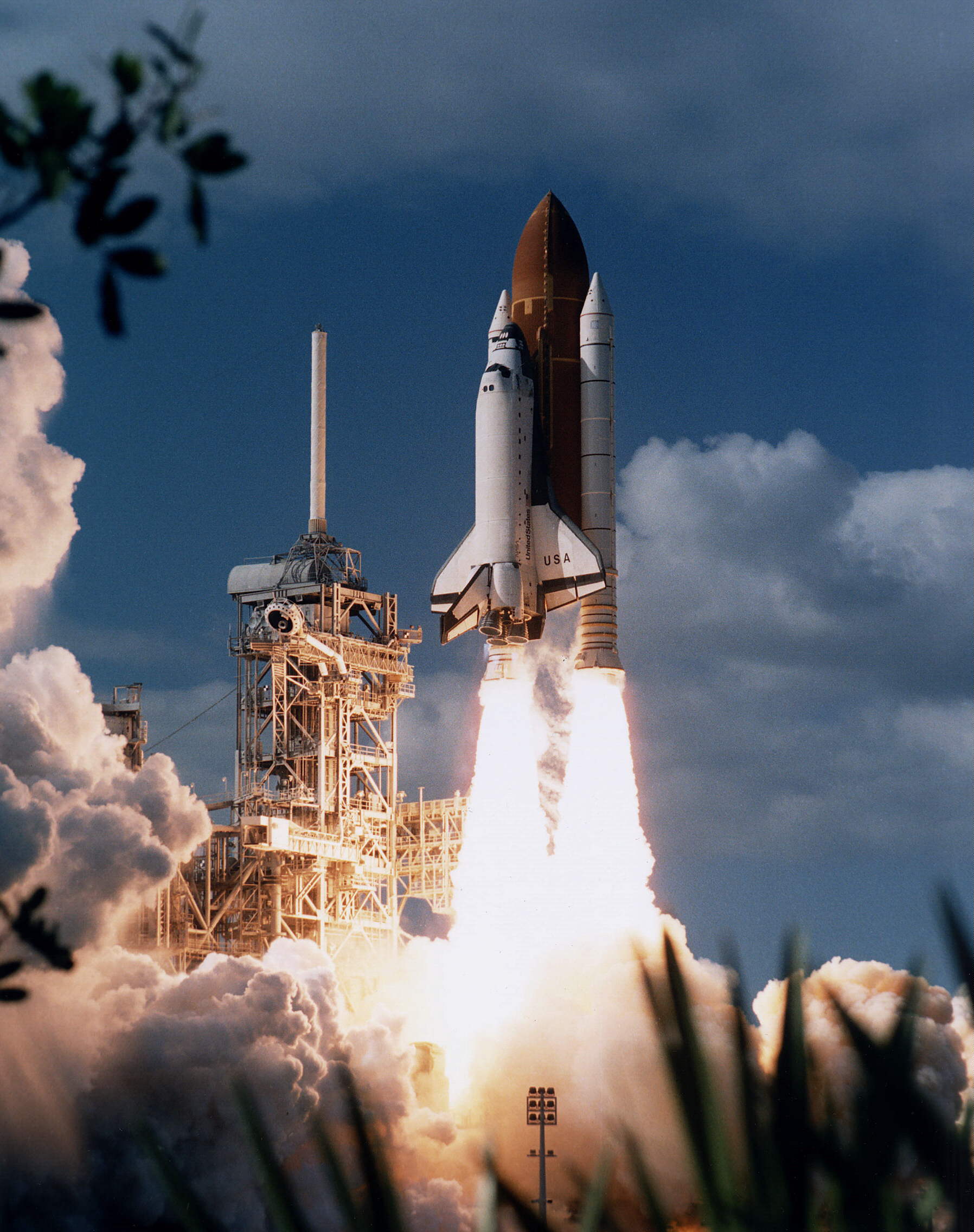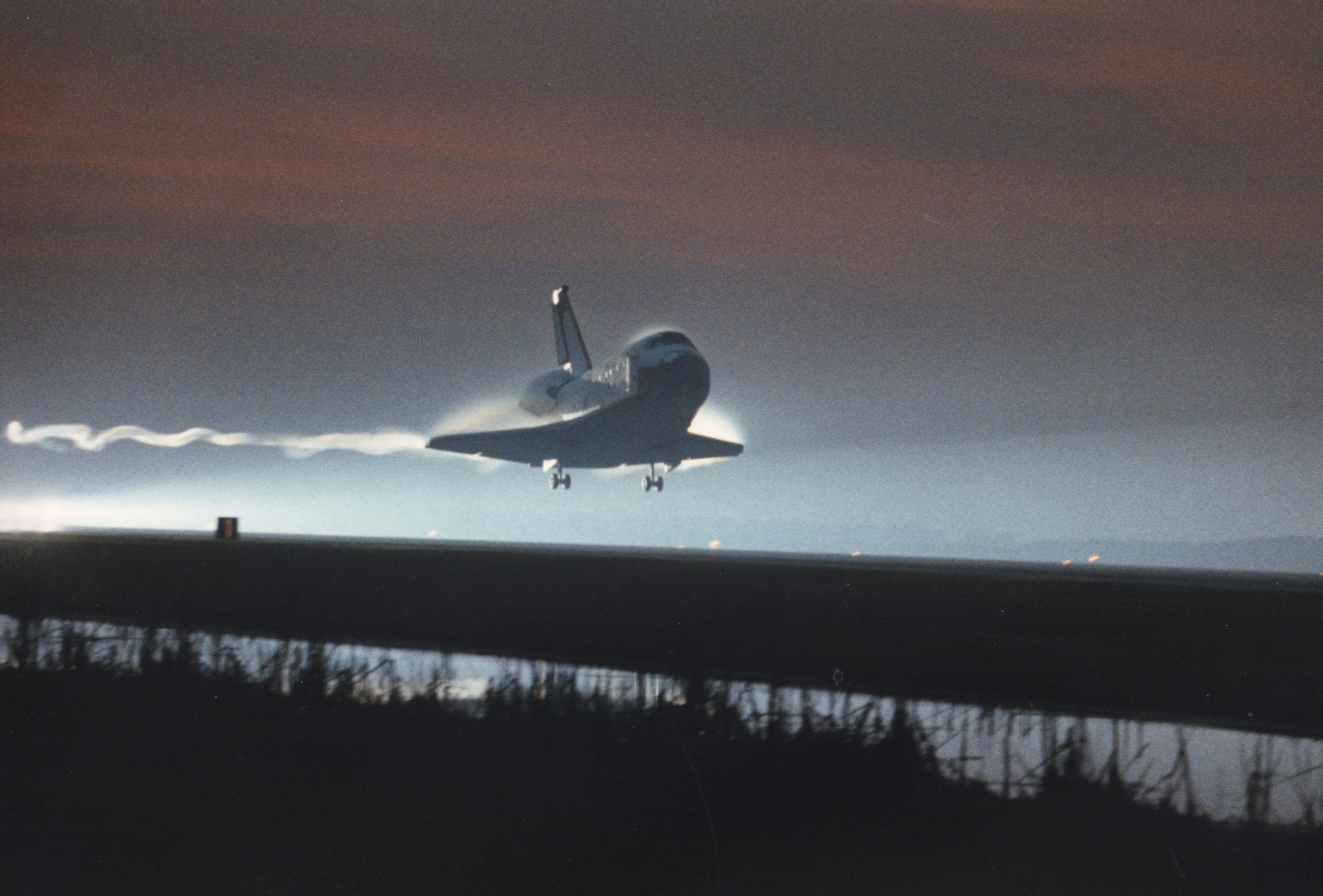STS-80 on:
[Wikipedia]
[Google]
[Amazon]
STS-80 was a
 ''Columbia'' brought with it two free floating satellites, both of which were on repeat visits to space. Also, a variety of equipment to be tested on two planned spacewalks was part of the payload. These would have been used to prepare for construction of the
''Columbia'' brought with it two free floating satellites, both of which were on repeat visits to space. Also, a variety of equipment to be tested on two planned spacewalks was part of the payload. These would have been used to prepare for construction of the
 ''Columbia'' carried into orbit two satellites that were released and recaptured after some time alone. The first was the Orbiting and Retrievable Far and Extreme Ultraviolet Spectrometer-Shuttle Pallet Satellite II (ORFEUS-SPAS II). The main component of the satellite, the ORFEUS telescope, had two spectrographs, for far and extreme ultraviolet.
Another spectrograph, the Interstellar Medium Absorption Profile Spectrograph, was also on board the satellite. Several payloads not relevant to astronomy rounded out the satellite. It performed without problems for its flight, taking 422 observations of almost 150 astronomical bodies, ranging from the
''Columbia'' carried into orbit two satellites that were released and recaptured after some time alone. The first was the Orbiting and Retrievable Far and Extreme Ultraviolet Spectrometer-Shuttle Pallet Satellite II (ORFEUS-SPAS II). The main component of the satellite, the ORFEUS telescope, had two spectrographs, for far and extreme ultraviolet.
Another spectrograph, the Interstellar Medium Absorption Profile Spectrograph, was also on board the satellite. Several payloads not relevant to astronomy rounded out the satellite. It performed without problems for its flight, taking 422 observations of almost 150 astronomical bodies, ranging from the

 Astronauts were selected for the mission on 17 January 1996. Stacking of the Solid Rocket Boosters (SRBs) began 9 September 1996. On 18 September, the launch date was bumped back from no earlier than (NET) 31 October to 8 November. Payload doors were closed on 25 September. The following day, the External fuel tank was mated to the SRBs inside the Vehicle Assembly Building.
Further progress was delayed while two windows on the orbiter were replaced; NASA feared that they might be susceptible to breakage after seven and eight flights. ''Columbia'' was rolled over to the VAB on 9 October to begin final assembly preparations.
Astronauts were selected for the mission on 17 January 1996. Stacking of the Solid Rocket Boosters (SRBs) began 9 September 1996. On 18 September, the launch date was bumped back from no earlier than (NET) 31 October to 8 November. Payload doors were closed on 25 September. The following day, the External fuel tank was mated to the SRBs inside the Vehicle Assembly Building.
Further progress was delayed while two windows on the orbiter were replaced; NASA feared that they might be susceptible to breakage after seven and eight flights. ''Columbia'' was rolled over to the VAB on 9 October to begin final assembly preparations.
 On 11 October, ''Columbia'' was mated with the external fuel tank, and the payload was delivered and transferred. Rollout to Pad 39B occurred on 16 October, which was followed by flight readiness checks of the main propulsion system.
After a Flight Readiness Review on 28 October, an additional FRR was requested to further analyze the Redesigned Solid Rocket Motor (RSRM) due to nozzle erosion that occurred on
On 11 October, ''Columbia'' was mated with the external fuel tank, and the payload was delivered and transferred. Rollout to Pad 39B occurred on 16 October, which was followed by flight readiness checks of the main propulsion system.
After a Flight Readiness Review on 28 October, an additional FRR was requested to further analyze the Redesigned Solid Rocket Motor (RSRM) due to nozzle erosion that occurred on
NASA mission summary
{{Use American English, date=January 2014 STS-080 Spacecraft launched in 1996
Space Shuttle
The Space Shuttle is a retired, partially reusable low Earth orbital spacecraft system operated from 1981 to 2011 by the U.S. National Aeronautics and Space Administration (NASA) as part of the Space Shuttle program. Its official program n ...
mission flown by Space Shuttle ''Columbia''. The launch was originally scheduled for 31 October 1996, but was delayed to 19 November for several reasons. Likewise, the landing, which was originally scheduled for 5 December, was pushed back to 7 December after bad weather prevented landing for two days.
It was the longest Shuttle mission ever flown at 17 days, 15 hours, and 53 minutes.
Although two spacewalks were planned for the mission, they were both canceled after problems with the airlock hatch prevented astronauts Tom Jones and Tammy Jernigan from exiting the orbiter.
Crew
Crew seating arrangements
*During landing, Musgrave remained on the flight deck in order to film the spacecraft's reentry through the overhead windows.Mission highlights
* The mission deployed two satellites and successfully recovered them after they had performed their tasks. * Orbiting and Retrievable Far and Extreme Ultraviolet Spectrometer-Shuttle Pallet Satellite
The shuttle pallet satellite was a satellite bus designed to be deployed and then retrieved for return to Earth on NASA's Space Shuttle
The Space Shuttle is a retired, partially reusable low Earth orbital spacecraft system operated from 19 ...
II (ORFEUS-SPAS II) was deployed on flight day one. It was captured on flight day sixteen.
* The Wake Shield Facility-3 was deployed on flight day 4, and was recaptured three days later.
* The mission was the longest mission in Space Shuttle history.
* On this mission, Story Musgrave became the only person to fly on all five Space Shuttles – ''Challenger'', ''Atlantis'', ''Discovery'', ''Endeavour'', and ''Columbia''.
* Musgrave also tied a record for spaceflights, and set a record for being the oldest man in space. Both records have since been surpassed.
Mission payload
 ''Columbia'' brought with it two free floating satellites, both of which were on repeat visits to space. Also, a variety of equipment to be tested on two planned spacewalks was part of the payload. These would have been used to prepare for construction of the
''Columbia'' brought with it two free floating satellites, both of which were on repeat visits to space. Also, a variety of equipment to be tested on two planned spacewalks was part of the payload. These would have been used to prepare for construction of the International Space Station
The International Space Station (ISS) is the largest Modular design, modular space station currently in low Earth orbit. It is a multinational collaborative project involving five participating space agencies: NASA (United States), Roscosmos ( ...
. Included in the Shuttle's payload were:
* Orbiting and Retrievable Far and Extreme Ultraviolet Spectrometer-Shuttle Pallet Satellite II (ORFEUS-SPAS II)
** Far Ultraviolet (FUV) Spectrograph
** Extreme Ultraviolet (EUV) Spectrograph
** Interstellar Medium Absorption Profile Spectrograph (IMAPS)
** Surface Effects Sample Monitor (SESAM)
** ATV Rendezvous Pre-Development Project (ARP)
** Student Experiment on ASTRO-SPAS (SEAS)
* Wake Shield Facility
Wake Shield Facility (WSF) was a NASA experimental science platform that was placed in low Earth orbit by the Space Shuttle. It was a diameter, free-flying stainless steel disk.
The WSF was deployed using the Space Shuttle's Canadarm. The WS ...
(WSF-3)
* NIH-R4
* Space Experiment Module (SEM)
* EVA Development Flight Tests (EDTF-5)
** Crane
** Battery Orbital Replacement Unit
** Cable Caddy
** Portable Work Platform
*** Portable Foot Restraint Work Station (PFRWS)
*** Temporary Equipment Restraint Aid (TERA)
*** Articulating Portable Foot Restraint
** Body Restraint Tether (BRT)
** Multi-Use Tether (MUT)
* Visualization in an Experimental Water Capillary pumped Loop (VIEW-CPL)
* Biological Research In Canister (BRIC)
* Commercial Materials Dispersion Apparatus Instrumentation Technology Associates Experiment (CCM-A) (formerly STL/NIH-C-6)
** Commercial MDA ITA Experiment (CMIX-5)
Scientific projects
 ''Columbia'' carried into orbit two satellites that were released and recaptured after some time alone. The first was the Orbiting and Retrievable Far and Extreme Ultraviolet Spectrometer-Shuttle Pallet Satellite II (ORFEUS-SPAS II). The main component of the satellite, the ORFEUS telescope, had two spectrographs, for far and extreme ultraviolet.
Another spectrograph, the Interstellar Medium Absorption Profile Spectrograph, was also on board the satellite. Several payloads not relevant to astronomy rounded out the satellite. It performed without problems for its flight, taking 422 observations of almost 150 astronomical bodies, ranging from the
''Columbia'' carried into orbit two satellites that were released and recaptured after some time alone. The first was the Orbiting and Retrievable Far and Extreme Ultraviolet Spectrometer-Shuttle Pallet Satellite II (ORFEUS-SPAS II). The main component of the satellite, the ORFEUS telescope, had two spectrographs, for far and extreme ultraviolet.
Another spectrograph, the Interstellar Medium Absorption Profile Spectrograph, was also on board the satellite. Several payloads not relevant to astronomy rounded out the satellite. It performed without problems for its flight, taking 422 observations of almost 150 astronomical bodies, ranging from the moon
The Moon is Earth's only natural satellite. It is the fifth largest satellite in the Solar System and the largest and most massive relative to its parent planet, with a diameter about one-quarter that of Earth (comparable to the width of ...
to extra-galactic stars and a quasar
A quasar is an extremely luminous active galactic nucleus (AGN). It is pronounced , and sometimes known as a quasi-stellar object, abbreviated QSO. This emission from a galaxy nucleus is powered by a supermassive black hole with a mass rangi ...
. Being the second flight of ORFEUS-SPAS II allowed for more sensitive equipment, causing it to provide more than twice the data of its initial run.
Also deployed from ''Columbia'' was the Wake-Shield Facility (WSF), a satellite that created an ultra-vacuum behind it, allowing for the creation of semiconductor thin films for use in advanced electronics. WSF created seven films before being recaptured by ''Columbia's'' robotic arm after three days of flight. The craft was on its third mission, including STS-60
STS-60 was the first mission of the U.S./Russian Shuttle-Mir Program, which carried Sergei K. Krikalev, the first Russian cosmonaut to fly aboard a Space Shuttle. The mission used NASA Space Shuttle ''Discovery'', which lifted off from Launc ...
, when hardware problems prevented it from deploying off the robotic arm. Wake Shield was designed and built by the Space Vacuum Epitaxy Center at the University of Houston
The University of Houston (UH) is a Public university, public research university in Houston, Texas. Founded in 1927, UH is a member of the University of Houston System and the List of universities in Texas by enrollment, university in Texas ...
in conjunction with its industrial partner, Space Industries, Inc.
Another inclusion was a Space Experiment Module (SEM). The SEM included student research projects selected to fly into space. This was the first flight of the program. Among the experiments conducted were analysis of bacteria growth on food in orbit, crystal growth in space, and microgravity's effect on a pendulum.
NIH.R4 was an experiment conducted for the National Institute of Health and Oregon Health Sciences University. It was designed to test the effects of spaceflight on circulation and vascular constriction. Biological Research in Canister (BRIC) explored gravity's effects on tobacco and tomato seedlings. Visualization in an Experimental Water Capillary Pumped Loop (VIEW-CPL) was conducted to test a new idea in thermal spacecraft management. The Commercial MDA ITA Experiment were a variety of experiments submitted by high school and middle school students sponsored by Information Technology Associates.
Mission background

 Astronauts were selected for the mission on 17 January 1996. Stacking of the Solid Rocket Boosters (SRBs) began 9 September 1996. On 18 September, the launch date was bumped back from no earlier than (NET) 31 October to 8 November. Payload doors were closed on 25 September. The following day, the External fuel tank was mated to the SRBs inside the Vehicle Assembly Building.
Further progress was delayed while two windows on the orbiter were replaced; NASA feared that they might be susceptible to breakage after seven and eight flights. ''Columbia'' was rolled over to the VAB on 9 October to begin final assembly preparations.
Astronauts were selected for the mission on 17 January 1996. Stacking of the Solid Rocket Boosters (SRBs) began 9 September 1996. On 18 September, the launch date was bumped back from no earlier than (NET) 31 October to 8 November. Payload doors were closed on 25 September. The following day, the External fuel tank was mated to the SRBs inside the Vehicle Assembly Building.
Further progress was delayed while two windows on the orbiter were replaced; NASA feared that they might be susceptible to breakage after seven and eight flights. ''Columbia'' was rolled over to the VAB on 9 October to begin final assembly preparations.
 On 11 October, ''Columbia'' was mated with the external fuel tank, and the payload was delivered and transferred. Rollout to Pad 39B occurred on 16 October, which was followed by flight readiness checks of the main propulsion system.
After a Flight Readiness Review on 28 October, an additional FRR was requested to further analyze the Redesigned Solid Rocket Motor (RSRM) due to nozzle erosion that occurred on
On 11 October, ''Columbia'' was mated with the external fuel tank, and the payload was delivered and transferred. Rollout to Pad 39B occurred on 16 October, which was followed by flight readiness checks of the main propulsion system.
After a Flight Readiness Review on 28 October, an additional FRR was requested to further analyze the Redesigned Solid Rocket Motor (RSRM) due to nozzle erosion that occurred on STS-79
STS-79 was the 17th flight of Space Shuttle ''Atlantis'', and the 79th mission of the Space Shuttle program. The flight saw ''Atlantis'' dock with the Russian space station Mir to deliver equipment, supplies and relief personnel. A variety of sc ...
; on the 29th, a fuel pump failed, delaying the fueling process of ''Columbia''. The erosion problem led to a week long delay instituted on 4 November. A launch date of 15 November was set, contingent on a successful Atlas launch two days prior. The forecast of bad weather pushed the launch back even further, to a date of 19 November.
Wake-up calls
NASA began a tradition of playing music to astronauts during theGemini program
Project Gemini () was NASA's second human spaceflight program. Conducted between projects Mercury and Apollo, Gemini started in 1961 and concluded in 1966. The Gemini spacecraft carried a two-astronaut crew. Ten Gemini crews and 16 individual ...
, which was first used to wake up a flight crew during Apollo 15
Apollo 15 (July 26August 7, 1971) was the ninth crewed mission in the United States' Apollo program and the fourth to land on the Moon. It was the first J mission, with a longer stay on the Moon and a greater focus on science than ear ...
.
Each track is specially chosen, often by their families, and usually has a special meaning to an individual member of the crew, or is applicable to their daily activities.
See also
*List of human spaceflights
This is a list of all human spaceflights throughout history. Beginning in 1961 with the flight of Yuri Gagarin aboard Vostok 1, human spaceflight occurs when a human crew flies a spacecraft into outer space. Human spaceflight is distinguish ...
* List of Space Shuttle missions
*Outline of space science
The following outline is provided as an overview and topical guide to space science:
Space science encompasses all of the scientific disciplines that involve space exploration and study natural phenomena and physical bodies occurring in outer ...
* STS-78 (16 day 21 hour Shuttle mission)
* STS-67 (16 days 15 hour Shuttle mission)
*STS-73
STS-73 was a Space Shuttle program mission, during October–November 1995, on board the Space Shuttle ''Columbia''. The mission was the second mission for the United States Microgravity Laboratory. The crew, who spent 16 days in space, were bro ...
(15 days 21 hours Shuttle mission)
References
External links
NASA mission summary
{{Use American English, date=January 2014 STS-080 Spacecraft launched in 1996